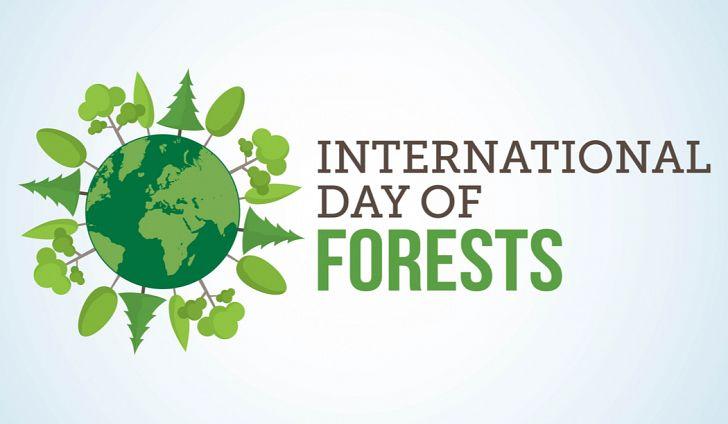International Day of forests

Copyright infringement is not intended
Context: International Day of Forests observed.
International Day of Forests 2022:
- Events on March 21 are organised the United Nations Forum on Forests, and the Food and Agriculture Organization of the United Nations (FAO), in collaboration with governments in various countries and other organisations working in this field.
- Theme: ‘Forests and Sustainable production and consumption.’
About International Day of Forests:
- The first-ever International Day of Forests was observed on March 21,
- It was established, on November 28, 2012, by a resolution of the United Nations General Assembly (UNGA).
- The aim behind observing the International Day of Forests is to ‘celebrate and raise awareness of the importance of all types of forests.’
Why Forests matters?
- According to a UN estimate, more than 1.6 billion people are directly dependent on forests for food, medicines, shelter, energy, shelter, income etc.
- Forests provide a significant portion of high-quality drinking water to nearly one-third of the world’s biggest cities, including New York, Tokyo and Barcelona.
Forest land in India:
- The word ‘forest’ is not defined in any Central Forest Act, namely the Indian Forest Act (1927), or the Forest Conservation Act (1980).
- The term ‘forest’ is yet to be defined by the Centreas the Central government has not laid down any criterion to define forest.
- Out of the recorded forest area in the country, 4,34,853 sq km fall under the Reserved Forests category, 2,18,924 sq km under the Protected Forests category, and 1,13,642 sq km are of unclassed forests.
Forest cover and tree cover
- The Ministry of Environment, Forest & Climate Change defines ‘forest cover’ in India as “all lands, more than one hectare in area with a tree canopy density of more than 10%”,
- ‘Tree cover’as “tree patches outside recorded forest areas exclusive of forest cover and less than the minimum mappable area of one hectare”.
- ‘Trees outside forest’, or TOF as “trees existing outside the recorded forest area in the form of block, linear & scattered size of patches”. Since tree cover measures only non-forest patches that are less than 1 hectare, it is only a part of TOF.
- Forest also has legal connotation. An area of land recorded as forest in revenue records or proclaimed to be forest under a forest law or Act is also described as forest.
- Thus, “forest area” is an area recorded as forest in the government records. Often this term is also written as “recorded forest area”.
- The recorded forest area is categorized into “Reserved Forest”, “Protected Forest” and “Unclassed Forest”.
- Reserved Forest: An area notified under the provisions of India Forest Act or the State Forest Acts having full degree of protection. In Reserved Forests all activities are prohibited unless permitted.
- Protected Forest: An area notified under the provisions of India Forest Act or the State Forest Acts having limited degree of protection. In Protected Forests all activities are permitted unless prohibited.
- Unclassed Forest: An area recorded as forest but not included in reserved or protected forest category. Ownership status of such forests varies from state to state.
Wasteland in India:
- As per the Wasteland Atlas, 2019, published by the Ministry of Rural Development, the total wasteland in the country is 5,57,665.51 sq km.
- Wasteland is defined not as desertified land, but land that not used for agriculture, commercial use or as forest land. For instance, it could use grasslands, that are used by communities for grazing.
State’s Power:
- State are responsible for categorising forest land, and resolving dispute between these two departments.
- The Indian Forest Act, 1927 gives statesthe rights to notify Reserved Forests in their areas.
Forest rights disputes:
- Rights such as that of grazing of animals are often not recorded, and the local community does not need to be consulted if the land were to be reclassified as ‘forest’ and diverted by the forest department. This often leads to disputes between local communities and governments.
- Most of the disputes over forest areas in the country arise from the contradictions in the legal statusof the land versus its actual use and status on the ground.
- The Supreme Court in the Godhvarman case post 1996ordered for bringing under purview of the Forest Conservation Act 1980 those forests which fall under the dictionary meaning of ‘forests’ irrespective of the legal category.
- SC also instructed the Environment Ministry to clarify the definition and the categories, including which are deemed forests.
- Forest Rights Act, 2006 (FRA 2006) grants forest rights to tribals and other traditional forest dwellers on all types of classified and unclassified and deemed forests as well.
https://www.un.org/en/observances/forests-and-trees-day



1.png)
